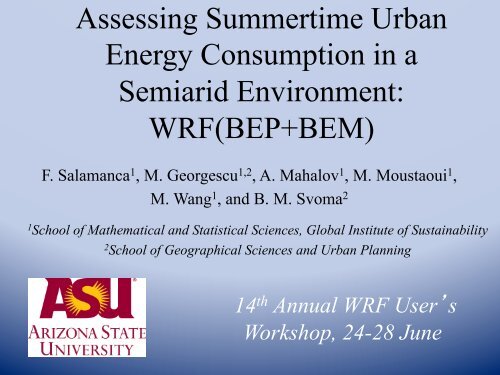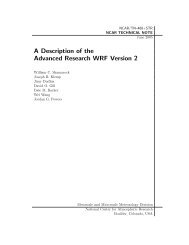Assessing Summertime Urban Energy Consumption in a ... - MMM
Assessing Summertime Urban Energy Consumption in a ... - MMM
Assessing Summertime Urban Energy Consumption in a ... - MMM
You also want an ePaper? Increase the reach of your titles
YUMPU automatically turns print PDFs into web optimized ePapers that Google loves.
<strong>Assess<strong>in</strong>g</strong> <strong>Summertime</strong> <strong>Urban</strong><br />
<strong>Energy</strong> <strong>Consumption</strong> <strong>in</strong> a<br />
Semiarid Environment:<br />
WRF(BEP+BEM)<br />
F. Salamanca 1 , M. Georgescu 1,2 , A. Mahalov 1 , M. Moustaoui 1 ,<br />
M. Wang 1 , and B. M. Svoma 2<br />
1<br />
School of Mathematical and Statistical Sciences, Global Institute of Susta<strong>in</strong>ability<br />
2<br />
School of Geographical Sciences and <strong>Urban</strong> Plann<strong>in</strong>g<br />
14 th Annual WRF User’s<br />
Workshop, 24-28 June
• Introduction<br />
Contents
Introduction<br />
• Why is important to assess <strong>Urban</strong> <strong>Energy</strong><br />
<strong>Consumption</strong>?<br />
ü Evaluation of energy demand is necessary <strong>in</strong> light<br />
of global projections of urban expansion.<br />
ü Of particular concern are rapidly expand<strong>in</strong>g urban<br />
areas <strong>in</strong> warm environments where AC energy<br />
demands are significant.
Introduction<br />
• How can we estimate <strong>Urban</strong> <strong>Energy</strong><br />
<strong>Consumption</strong>?<br />
Observations:<br />
Total load<br />
values from<br />
power<br />
company <br />
Meteorology<br />
( cool<strong>in</strong>g/heat<strong>in</strong>g<br />
consumption) <br />
Human behavior<br />
consumption
Introduction<br />
• How can we estimate <strong>Urban</strong> <strong>Energy</strong><br />
<strong>Consumption</strong>?<br />
ü Cool<strong>in</strong>g/Heat<strong>in</strong>g<br />
energy requirements<br />
can be predicted<br />
with the WRF<br />
model <strong>in</strong><br />
conjunction with<br />
build<strong>in</strong>g energy<br />
parameterizations.<br />
<strong>Urban</strong> <br />
morphology <br />
Air <br />
quality <br />
<strong>Energy</strong> <br />
consump7on <br />
<strong>Urban</strong> <br />
climate
Introduction<br />
• How can we estimate <strong>Urban</strong> <strong>Energy</strong><br />
<strong>Consumption</strong>?<br />
Observations:<br />
Total load<br />
values from<br />
power<br />
company <br />
Meteorology<br />
( cool<strong>in</strong>g/heat<strong>in</strong>g<br />
consumption) <br />
Human behavior<br />
consumption <br />
WRF<br />
(BEP+BEM)<br />
simulations
Contents<br />
• Introduction<br />
• Application area
Application Area
Application Area<br />
• We focus on the rapidly expand<strong>in</strong>g<br />
Phoenix Metropolitan Area (PMA).
Application Area<br />
• We focus on the rapidly expand<strong>in</strong>g<br />
Phoenix Metropolitan Area (PMA).<br />
• The expand<strong>in</strong>g built environment is<br />
expected to raise summertime<br />
temperatures considerably.
Application Area<br />
• We focus on the rapidly expand<strong>in</strong>g<br />
Phoenix Metropolitan Area (PMA).<br />
• The expand<strong>in</strong>g built environment is<br />
expected to raise summertime<br />
temperatures considerably.<br />
• Air Condition<strong>in</strong>g cool<strong>in</strong>g requirements<br />
are excessive <strong>in</strong> summer.
Contents<br />
• Introduction<br />
• Application Area<br />
• Simulations
Simulations v The WRF (V3.4.1) simulations were<br />
performed with four two-way nested<br />
doma<strong>in</strong>s with a grid spac<strong>in</strong>g of 27, 9,<br />
3, and 1 km respectively. The<br />
number of vertical sigma pressure<br />
levels was 40 (14 levels <strong>in</strong> the lowest<br />
1.5 km).<br />
v The simulations were conducted with<br />
the NCEP F<strong>in</strong>al Analyses data<br />
(number ds083.2) cover<strong>in</strong>g a 10-day<br />
EWD period from 00 LT July 10 to<br />
23 LT July 19, 2009.<br />
v The US Geological Survey 30m 2006<br />
National Land Cover Data set was<br />
used to represent modern-day LULC<br />
with<strong>in</strong> the Noah-LSM for the urban<br />
doma<strong>in</strong>. Three different urban classes<br />
describes the morphology of the city:<br />
COI, HIR and LIR.<br />
v The build<strong>in</strong>g energy parameterization<br />
(BEP+BEM) was applied to the<br />
fraction of grid cells with built cover.
Simulations<br />
2m-Air Temperature ( 0 C)<br />
<strong>Urban</strong> Stations<br />
RMSE=1.698 0 C<br />
MAE =1.343 0 C<br />
Simulated <br />
Rural Stations<br />
RMSE=1.700 0 C<br />
MAE =1.305 0 C<br />
Observed
Contents<br />
• Introduction<br />
• Application Area<br />
• Simulations<br />
• Splitt<strong>in</strong>g the <strong>Energy</strong> <strong>Consumption</strong>
Splitt<strong>in</strong>g the <strong>Energy</strong> <strong>Consumption</strong><br />
v Observed total load values obta<strong>in</strong>ed from an electric<br />
utility company were split <strong>in</strong>to two parts, one l<strong>in</strong>ked to<br />
meteorology (AC consumption), and another to human<br />
behavior consumption (HBC).<br />
v To estimate the HBC two approaches were considered<br />
for March and November based on the assumption that<br />
heat<strong>in</strong>g/cool<strong>in</strong>g energy consumption for these months<br />
was small (ensemble of m<strong>in</strong>imum consumption days<br />
denoted as M1, M2, N1, and N2).
Splitt<strong>in</strong>g the <strong>Energy</strong> <strong>Consumption</strong><br />
v Observed total load values obta<strong>in</strong>ed from an electric<br />
utility company were split <strong>in</strong>to two parts, one l<strong>in</strong>ked to<br />
meteorology (AC consumption), and another to human<br />
behavior consumption (HBC).<br />
v To estimate the HBC two approaches were considered<br />
for March and November based on the assumption that<br />
heat<strong>in</strong>g/cool<strong>in</strong>g energy consumption for these months<br />
was small (ensemble of m<strong>in</strong>imum consumption days<br />
denoted as M1, M2, N1, and N2).
Contents<br />
• Introduction<br />
• Application Area<br />
• Simulations<br />
• Splitt<strong>in</strong>g the <strong>Energy</strong> <strong>Consumption</strong><br />
• Results
Ratio of observed AC consumption to total<br />
electric consumption<br />
Dur<strong>in</strong>g even<strong>in</strong>g hours<br />
the 65% of the total<br />
electric consumption<br />
is due to the use of the<br />
A C s y s t e m s . A C<br />
systems accounted for<br />
~ 53% averaged across<br />
the diurnal cycle.<br />
M1<br />
M2<br />
N1<br />
N2<br />
Normalized time of day<br />
t=0.25 sunrise<br />
t=0.75 sunset<br />
The time scale of<br />
the hourly loads<br />
was normalized to<br />
m<strong>in</strong>imize monthly<br />
variation.
Diurnal Mean AC <strong>Consumption</strong><br />
Park<strong>in</strong>g structures, home<br />
garages, etc are represented as<br />
air conditioned build<strong>in</strong>gs when<br />
these spaces are not really<br />
cooled.<br />
Assum<strong>in</strong>g 65% of <strong>in</strong>door volume<br />
i s c o o l e d f o r t h e P M A ,<br />
WRF(BEP+BEM)-simulated<br />
results are <strong>in</strong> excellent<br />
agreement with observational<br />
data.<br />
BEP+BEM (65%)<br />
M1<br />
M2<br />
N1<br />
N2
Non-dimensional AC consumption profiles<br />
BEP+BEM<br />
M1<br />
M2<br />
N1<br />
N2<br />
Diurnal evolution of<br />
observed and simulated<br />
AC consumption as a<br />
fraction of total AC<br />
consumption.<br />
The general shape of<br />
model-simulated nond<br />
i m e n s i o n a l A C<br />
consumption profiles<br />
w a s a p p a r e n t f o r<br />
different Extreme Heat<br />
Events <strong>in</strong> July.
2D-Diurnal Mean AC Electric <strong>Consumption</strong>
Contents<br />
• Introduction<br />
• Application Area<br />
• Simulations<br />
• Splitt<strong>in</strong>g the <strong>Energy</strong> <strong>Consumption</strong><br />
• Results<br />
• Conclusions
Conclusions<br />
v The hourly ratio of AC to total electric consumption<br />
accounted for 53% of diurnally averaged total electric<br />
demand, rang<strong>in</strong>g from 35% dur<strong>in</strong>g early morn<strong>in</strong>g to<br />
65% dur<strong>in</strong>g even<strong>in</strong>g hours.<br />
v WRF(BEP+BEM)-simulated non-dimensional AC<br />
consumption profiles compared favorably to diurnal<br />
observations <strong>in</strong> terms of both amplitude and tim<strong>in</strong>g.<br />
v Assum<strong>in</strong>g 65% of <strong>in</strong>door volume is cooled for the PMA,<br />
WRF(BEP+BEM)-simulated results are <strong>in</strong> excellent<br />
agreement with observational data.<br />
v The presented methodology establishes a new energy<br />
consumption-model<strong>in</strong>g framework that can be applied to<br />
any urban environment where the use of the AC systems<br />
is prevalent across the entire metropolitan area.
Simulations<br />
2m-Air Temperature ( 0 C)<br />
Daytime <strong>Urban</strong> Cool<strong>in</strong>g<br />
Nighttime <strong>Urban</strong> Heat Island
Simulations<br />
10m-W<strong>in</strong>d Speed (m/s) 10m-W<strong>in</strong>d Direction ( 0 )<br />
<strong>Urban</strong> Stations<br />
Rural Stations<br />
Observed <br />
Simulated
Splitt<strong>in</strong>g the <strong>Energy</strong> <strong>Consumption</strong> <br />
v For the first method we select the day with the m<strong>in</strong>imum<br />
total load (EC1) and the day with the m<strong>in</strong>imum hourly<br />
load range (EC2) (methods N1 and M1):<br />
HBC i<br />
=<br />
EC1 i + EC2 i<br />
2<br />
for all i =1,...,24<br />
v For the second method, the m<strong>in</strong>imum hourly load was<br />
selected for each hour of the day consider<strong>in</strong>g the entire<br />
month (methods N2 and M2):<br />
HBC i<br />
= m<strong>in</strong> j<br />
(EC ij<br />
)for all i =1,...,24;<br />
j =1,...,30 (November), 31(March)
















